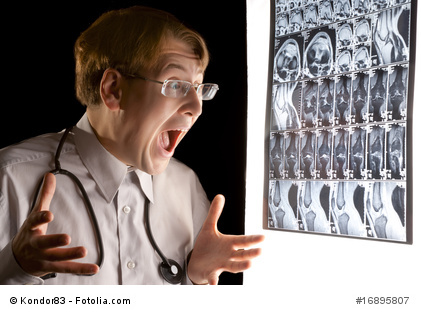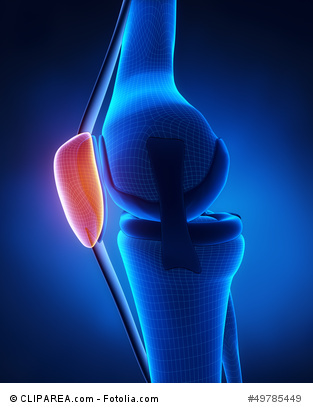Well then, allow me to explain why knee pain is making you insane!
As you probably know, the knees take a ton of abuse and problems with them are a very common reason why so many people go to professionals like sports medicine doctors and doctors of physical therapy.

The above is probably what your doctor looks like when he gets another knee patient. At least…that is how I looked when I got my first knee patient cause my instructor had left me alone for the very first time to fend for myself!
Why is the knee such a common source of pain for so many people?
It is for MANY reasons. Not only do problems originating at the knee present an issue in the immediate area, but problems from the hips and feet can effect the knee as well.
Here is a look at the knee so you can visualize what I am talking about. I tried to find a more in depth picture but Fotolia.com did not have one and the ones that were detailed were in German, which I do not speak.

This is a side view of the knee. The tendon up top originates from your Quadriceps muscles, thus its name, Quadriceps Tendon. It comes from up above, attaches to the patella bone (in red) and continues on as the Patellar Ligament, which attaches below on a bump of the Tibia bone (Tibial Tuberosity).
The patella normally is on a groove in the femur (name of bone that is upper leg). As you bend and extend your knee, the patella travels up and down the groove. If there are muscular imbalances or poor body mechanics though, the patella can move improperly in the groove and lead to something known as Patellofemoral Pain Syndrome. Over time this can lead to cartilage degeneration and osteoarthritis, which is when there is no cartilage left between the bones and the bones themselves rub against one another!
So now I am going to discuss issues at the hips, knees and feet that lead to knee pain and Patellofemoral Pain Syndrome.
HIP ISSUES THAT LEAD TO KNEE PAIN:
Having weak glutes or the muscles on your butt will lead to knee pain over time. Your glutes will help keep you stable as you walk. If your foot is baring weight on the ground as you take a step, your glutes will be able to prevent your knees from twisting inwards and causing pain and damage to muscles, tendons and ligaments over time. Your body is like a chain and weakness at your glutes can lead to your knees being battered.
Something also known as the Q-Angle can lead to knee issues. The Q-Angle is pretty much a line coming from your hip down towards your kneecap. The wider your pelvis, the greater your Q-Angle. This Q-Angle can cause excessive pulling at the patella, especially in women who tend to have wider pelvises than men.
WHAT GOING WRONG AT THE KNEE CAN CAUSE PAIN THERE?
There is only one muscle in the knee that pulls the kneecap inward, and that muscle is the VMO (Vastus Medialis Oblique). If it is weak or misfiring, the patella will track wrong and lead to knee pain.
If the IT Band (Iliotibial Band) is tight, it will pull sideways at your patella, leading to pain.
Tight hamstrings from not stretching enough will cause a lack of motion at the knee. Since your hamstrings bend the knee, picture them being tight and your kneecap being more compressed. This most certainly will over time lead to knee pain.
Also, having knock-knees or being bow-legged will lead to knee pain.
WHAT PROBLEMS AT THE FOOT CAN LEAD TO KNEE PAIN?
Flat feet will cause your lower leg to twist inwards, causing your kneecap to move improperly and lead to knee pain.
Having high arched feet will over time lead to knee pain due to a lack of shock absorption and that shock traveling up your knee.
Tight calves may also cause decreased flexibility during walking and will cause your body to adapt by developing flat feet, which will lead to knee pain.
I hope you all enjoyed that blog post…there will be much more to follow!
References:
1. Powers, C.M. The Influence of Abnormal Hip Mechanics on Knee Injury: A Biomechanical Perspective. Journal of Orhopaedic & Sports Physical Therapy.
2010; 40(2): 42-51.
2. Aliberti, S. et al. Medial contact and smaller plantar loads characterize individuals with Patellofemoral Pain Syndrome during stair descent. Physical Therapy in Sport.
2010; 11: 30-34.
3. Dixit, S. et al. Management of Patellofemoral Pain Syndrome. American Family Physician. 2007; 75(2): 194-202.
4. Levangie, P.K., Norkin C.C. Joint Structure and Function. 5th edition. F.A. Davis Company. Philadelphia, PA. 2011.
5. Collins N. et al. Foot orthoses and physiotherapy in the treatment of patellofemoral pain syndrome: randomized clinical trial. Br J Sports Med. 2009; 43: 169-171.
